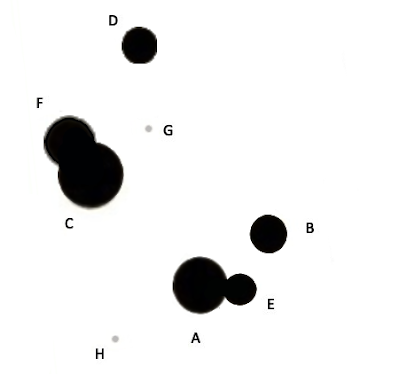Imaging the six bright stars of the The Orion Trapezium Cluster
The Trapezium Cluster is an open cluster at the centre of the Orion Nebula (M42). It has an apparent magnitude of 4.0 and lies at a distance of 1,600 light years. It subtends 47 arc seconds of sky.
It is also known as the Orion Trapezium Cluster or Theta-1 Orionis, the Trapezium Cluster can be resolved in 5-inch telescopes, which reveal six of the cluster’s stars if observing conditions are good. The cluster is easy to identify because the brightest four stars form an asterism shaped like a trapezium after which it was named. Robert Julius Trumpler was the first to use the name 'Trapezium'. The stars are luminous X-ray sources and are responsible for most of the glow of the surrounding nebula.
The Trapezium Cluster was discovered by Galileo Galilei in 1617, who sketched three of the cluster’s stars, but not the surrounding Orion Nebula. This is an interesting fact and the very narrow field of view of his telescope could have been a contributing factor. However, the Orion nebulosity was not noted in Ptolomy's 'Almagest' where the Trapezium was recorded as a bright star, or Al Sufi's 'Fixed Stars', both of which recorded nebulosity in other parts of the sky. In 1603 Johann Bayer catalogued the ‘star’ as Theta Orion in Uranometria. It may be that increased activity of the illuminating stars has increased the brightness of the nebulosity rendering it more readily visible since those times. It is possible to speculate that the sky transparency due to humidity, smoke or moonlight (which does not interfere with the observation of stars) contributed to the obscuration of the nebula for some observers.The discovery of the Orion nebulosity is credited to Nicolas-Claude Fabri de Peiresc in 1610. His patron, Guillaume du Vair, purchased a refracting telescope in 1610 with which de Peiresc likely observed the Orion nebulosity. As the discovery of the nebulosity predates Galileo’s discovery of the Trapezium by seven years, it is an open question as to why Galileo missed it, and indeed, why other, superbly competent observers made no mention of it. Christiaan Huygens independently discovered the three stars in 1656. The fourth member, Theta-1 Orionis B, was discovered by Jean Picard in 1673, completing the Trapezium. Huygens also observed the fourth component in 1684.
Several more stars were discovered in 1673 and, by 1888, a total of eight members were known; some of which are binaries. The cluster contains many more stars too faint to be easily visible, including a number of brown dwarfs.
Attempts to resolve the stars of the Trapezium
We used a Skymax 127 Maksutov SV305-F (minus IR/UV cut filter) combination mounted on a Celestron AVX mount, aimed at the Trapezium region of the Orion nebula and 93 x 15s, 16-bit exposures were captured using AstroDMx Capture for macOS with matching dark-frames: all under a full Moon. We obtained these results over 14 months ago.
Screenshot of AstroDMx Capture for macOS capturing data on the Trapezium region of the Orion nebula.
The data were stacked to produce the final image of the Trapezium region.
The six stars of the Trapezium can be seen as bright stars against a bright nebulosity background. The bottom left star of the Trapezium is just about resolving into two components and the bottom right star is more clearly resolved.
Various processing techniques were used to reveal the six stars more clearly.
The Trapezium region cropped out of the main image
Negative image with adjusted levels
The six stars are more evident in this image.
Unsharp-masking by Fitswork’s Special Filter
The six components of the Trapezium stars are more readily discerned
The Trapezium region cropped out of the main image
As well as a general sharpening, the unsharp masking Fitswork’s special filter has darkened the background nebulosity and to a degree the bottom four component stars of the Trapezium which are just resolved in the image.
Negative image with adjusted levels
These images leave little doubt that six stars have been revealed if not fully resolved.
Star map of the Trapezium to clarify the positions of the partially resolved stars
The six stars of the trapezium are labelled A through F. The positions of two other much fainter stars are shown as G and H.
Negative image
The stars of the Trapezium pose an interesting challenge to observers and imagers attempting to resolve them. Observers in locations such as the UK which frequently suffers from the disruptive effects of the jet stream and poor seeing, and where Orion is quite low in the sky, are less likely to be able to achieve the resolving of the component stars on an average night. More southerly locations where the jet stream is out of the way and Orion is higher in the sky are likely to facilitate the resolution of the Trapezium's component stars.







